Some things come full circle in life.
Having started out as a youth player in the River Plate academy in the early ‘90s as an upcoming prospect, Martín Demichelis is back at Rio del la Plata as a bright, young coach, attempting to lead the Argentine giants in a new direction following the lengthy reign of Marcelo Gallardo.
Having left his native country twenty years ago for the lustrous land of Europe, Demichelis made a great career for himself playing for some of the continent’s biggest clubs including Bayern Munich and Manchester City, gaining some valuable knowledge from the best coaches around such as Louis van Gaal, Ottmar Hitzfeld and Manuel Pellegrini.
Pellegrini in particular has been cited as a massive inspiration for Demichelis, having worked under the Chilean coach at three different clubs in his playing career, picking up several trophies.
Nevertheless, the now-42-year-old also earned some great experience as the head coach of Bayern’s U19s and Bayern Munich II before taking the massive leap by succeeding Gallardo at River Plate.
While he’s still learning his trade, Demichelis has become somewhat of a tactical chameleon so far at the Estadio Mâs Monumental which will be explained later in this analysis.
This Martín Demichelis tactical analysis piece will take a look at some of the more intriguing elements of the former defender’s tactics with Los Millonarios after just a few months in charge of the club.
Martín Demichelis Tactics & Formations
An ongoing debate in the analytics stratosphere is the discussion surrounding formations and whether their meaning has dwindled throughout the recent tactical development within the sport.
Some fall on the spectrum that formations no longer have much reason for existence and that the roles of each player far outweigh set formational positions.
Pep Guardiola himself once labelled formations as mere ‘telephone numbers’.
Others believe that formations and shapes are highly beneficial tools for players to understand organisation and attacking as well as defending as a collective.
Then there are those who fall somewhere in the middle, believing that formations have some role, but they are not the be-all and end-all of football tactics.
When watching Demichelis’ River Plate, you can’t help but feel as though the ex-Argentina international leans closer to the first prong of the argument.
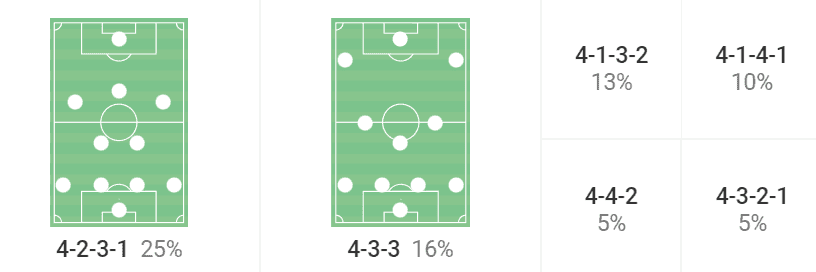
Wyscout have calibrated that the 4-2-3-1 has been the young coach’s preferred formation this season, a structure synonymous with Pellegrini, particularly over the last decade and a half.
But the 4-2-3-1 isn’t ahead by much.
However, it is also clear that a wealth of formations have been used during Demichelis’ reign so far at River Plate.
Other shapes include the 4-3-3, the 4-1-4-1, the 4-4-2, the 4-1-3-2 and the 4-3-2-1.
No back three formations have been utilised thus far but it’s still early days into his tenure so there is still room for experimentation.
In fact, in one of River Plate’s most recent matches, Demichelis changed the team’s formation four times in one match, switching from a 4-3-3 to a 4-3-2-1 to a 4-2-2-2 before eventually concluding with a 4-2-1-3.
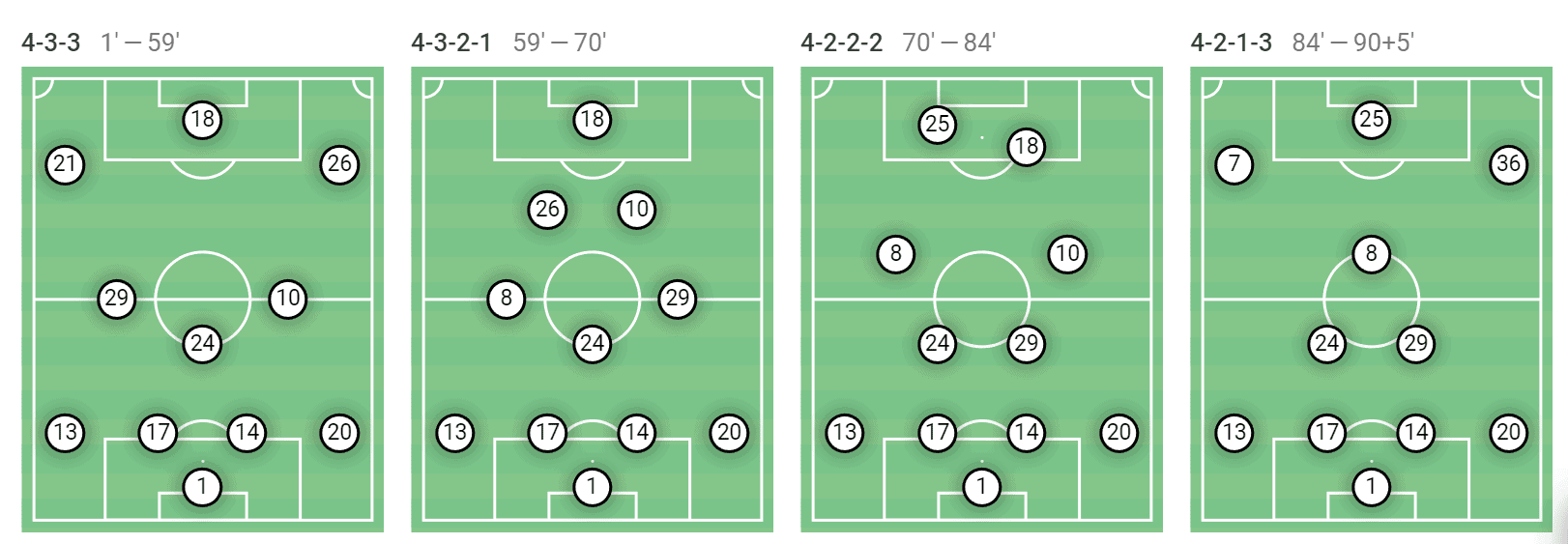
Regardless, what this data tells us is that Demichelis really doesn’t take much heed of the base positions his players take up.
Principles of play are undoubtedly the most important aspect of his coaching philosophy as well as how his side move the ball around the pitch.
Perhaps out of possession is where a little more rigidity is brought into the team and some tactical discipline, but it is clear from watching River Plate this season that analysing formations have become a little meaningless in possession.
So, with that in mind, the rest of this analysis will focus specifically on some of the most interesting tactical principles that Demichelis is implementing with the four-time Copa Libertadores champions, without homing in on ‘telephone numbers’.
Possession, possession and more possession
Given some of the wonderful managers that Demichelis played under, it’s no surprise that his philosophy is centred around having the ball.
Both Pellegrini and van Gaal are two of his biggest influences, although he may not have always seen eye-to-eye with the latter.
Even Pep Guardiola has been influential to the young head coach’s philosophy despite having never played under the current Manchester City boss, leaving the summer of his arrival at the Etihad Stadium in 2016.
In an interview in 2020, Demichelis cited the different ways in which the trio have guided his belief of how football should be played:
“His philosophy was always very similar to that of Pep Guardiola in that he always wanted us to be dominant.
“From van Gaal I learned the importance of control, passing and the movement of the ball.
In the 18 months I worked with him, there was never an exercise without the ball.
I love that philosophy.”
From River Plate’s statistics this season, ranking the South American giants against the rest of the Liga Profesional, the influence of Pellegrini, van Gaal and Pep is evident:
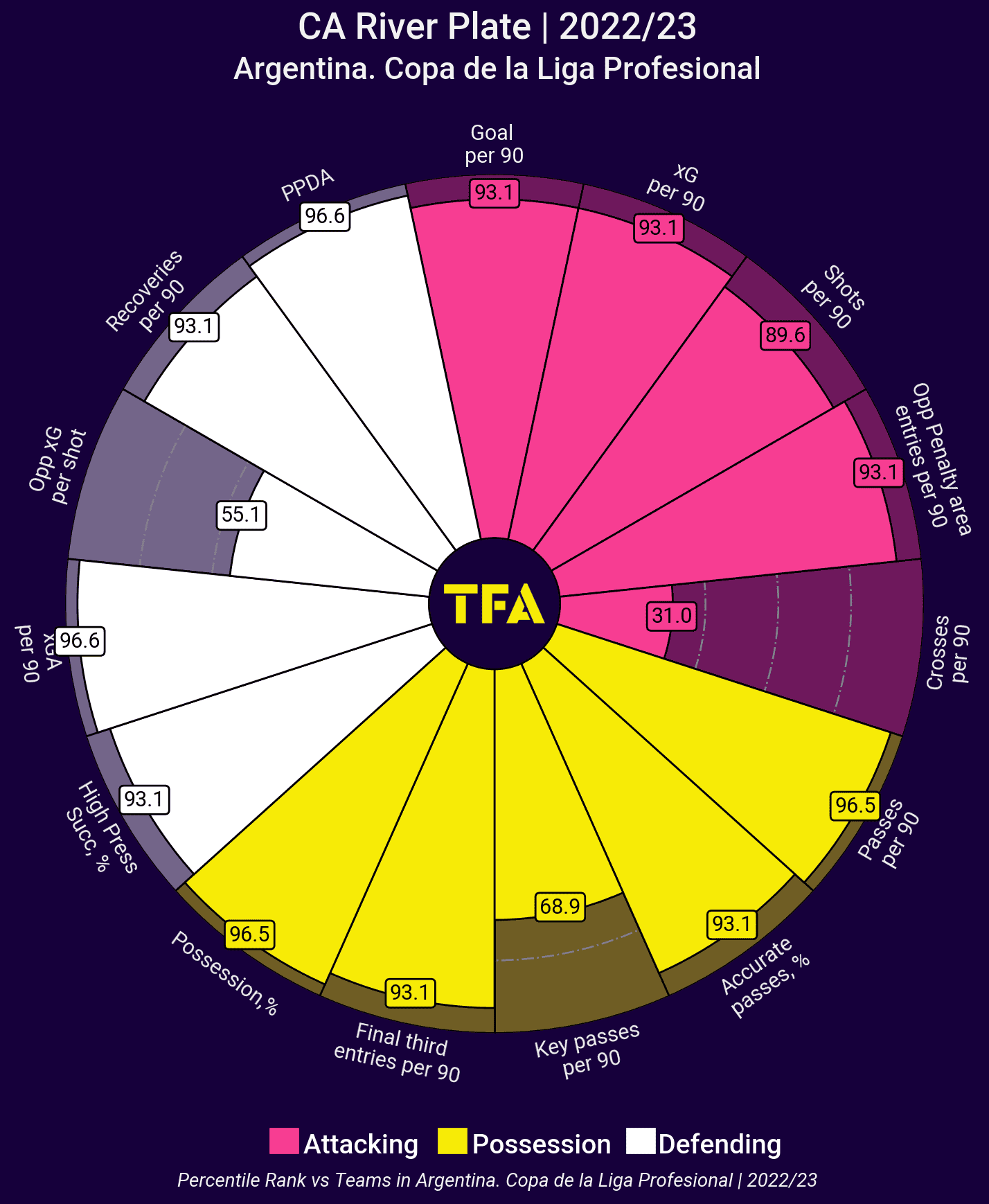
River Plate rank incredibly high on most metrics, particularly attacking stats such as possession percentage, accurate passes, passes per 90, final third entries, opposition penalty area entries per 90, shots per 90, xG per 90 and goals per 90.
The only attacking metric where River Plate lag behind is in crosses per 90 but there is a tactical reason for this centred around Demichelis’ philosophy which will be discussed later in this piece.
Teams tend not to press against River Plate during his reign due to the quality that the side possess at the back such as centre-backs Paulo Díaz and Inter Miami loanee Leandro González Pírez and fullbacks Milton Casco and Enzo Díaz as well as World Cup-winning goalkeeper Franco Armani who are all excellent on the ball.
This season, River Plate have averaged a PPDA of 13.3 against them in all competitions.
While the season is only a few weeks into its commencement and the sample size may be relatively small, it still shows a trend that most teams allow Demichelis’ side to bypass the build-up phase.
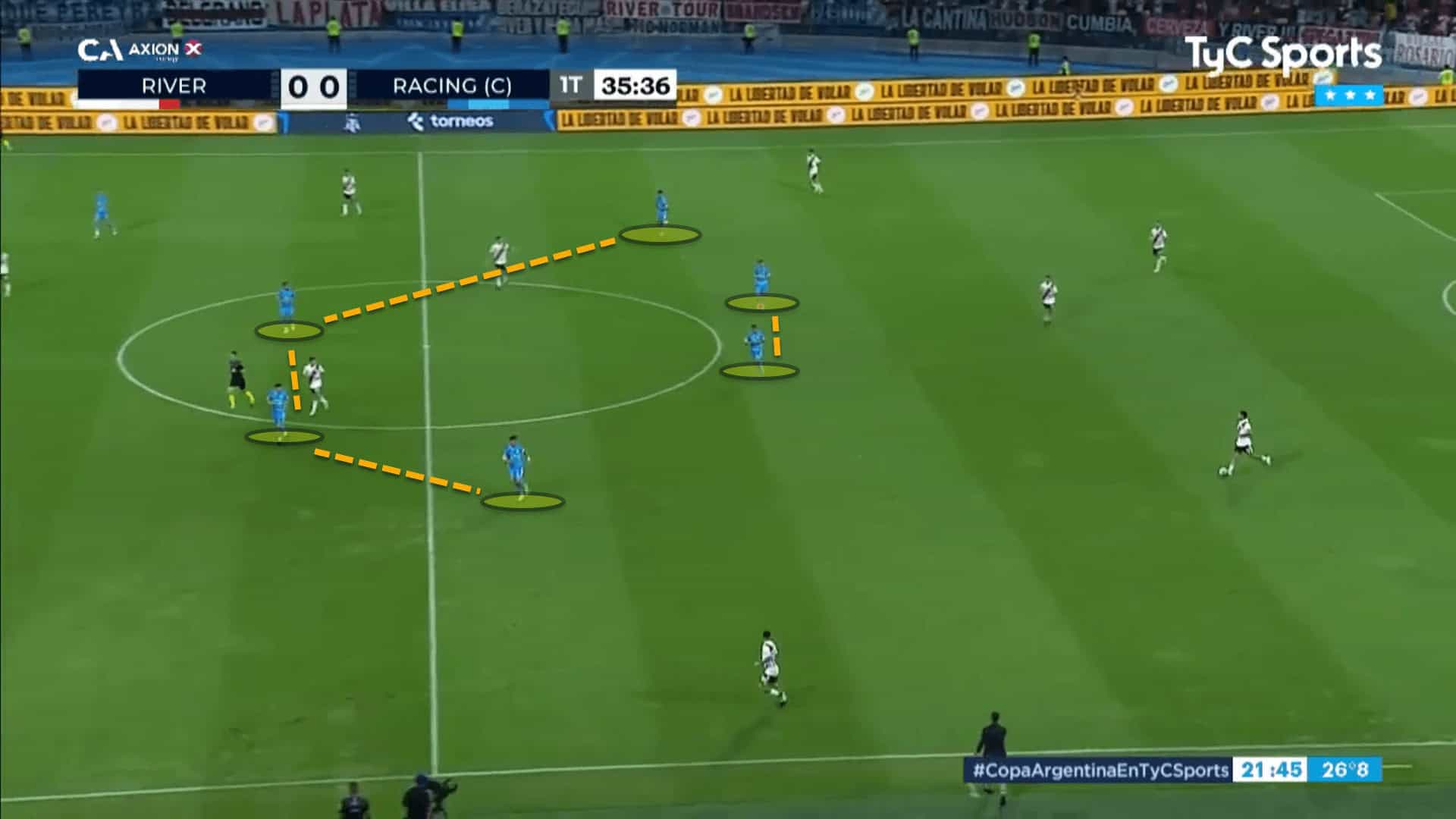
Here, in a cup match versus Club Atlético Racing, managed by the former Argentina national team goalkeeper Carlos Bossio, River Plate were able to come out from the back unscathed with no pressure being applied from the visitors.
Bossio’s men were not interested in pressing high up the pitch, preferring to drop off and consolidate in a 4-4-2 mid-block and blocking out the centre of the pitch where River Plate were stacked.
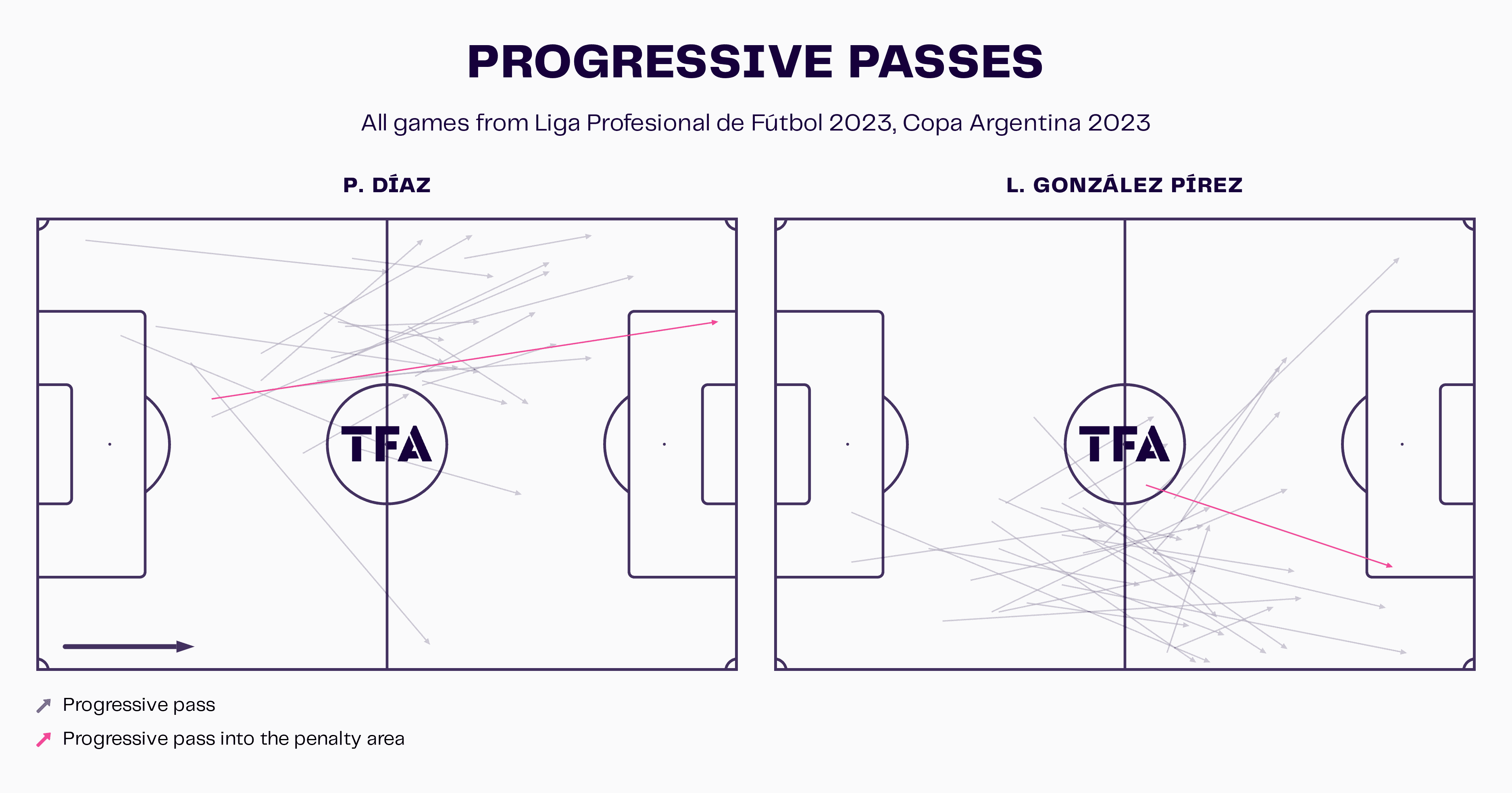
This is backed up by the primary centre-backs’ progressive passing map this season.
Across both men in all competitions, very few of their progressive passes come from the first third of the pitch.
The opportunity to break the opposition’s press is rarely there and so they have it quite easy in this area of the pitch.
It is around the middle third of the field where Los Millonarios do most of their good work after the opposition have settled into their defensive structure of choice.
In this phase, the fullbacks get extremely high as there are generally no other width-holders on the pitch since Demichelis orders his midfield and forward line to push inside and dominate the central spaces.
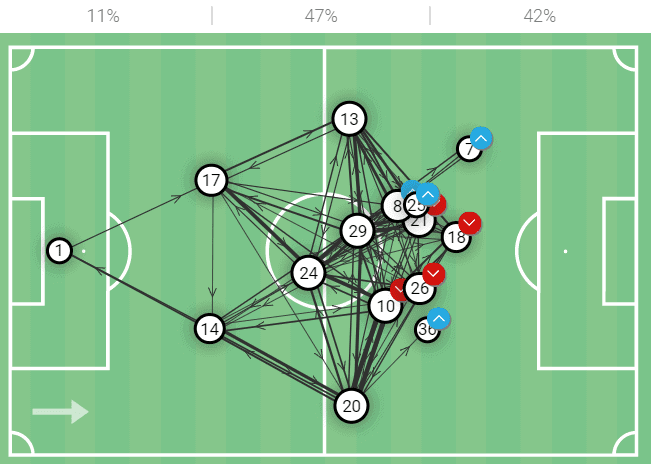
From the side’s pass map in a recent game against Godoy Cruz, the team’s tactical set-up is clear.
The fullbacks push high and wide while the rest of the team overload the areas between the opposition’s lines.
Apart from the positioning of the fullbacks and the centre-backs, the rest of the outfield players are incredibly fluid and are not confined to the limitations of a structure.
It would be wrong to label Demichelis’ style as resemblant of positional play.
Instead, space dictates what areas of the pitch players position themselves, not zones.
The manager encourages his players to move around, come short for the ball and make off-the-ball movements to create space for others.
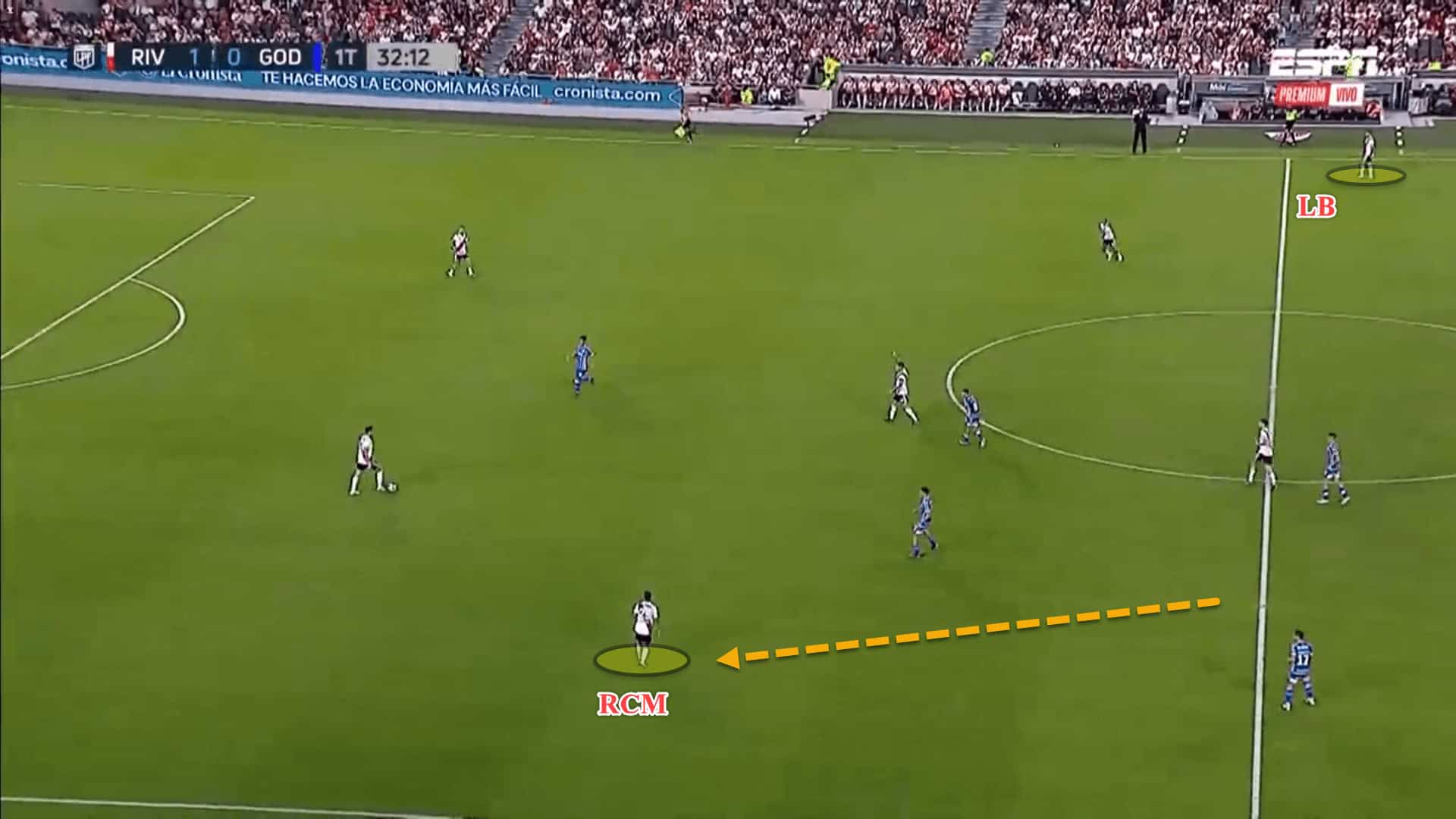
In this game, River Plate set up in a 4-3-2-1 on paper, playing with three central midfielders and two creative wingers who acted as double number ‘10s’.
However, the freedom for movement of these five players was limitless.
In the previous example, the right central midfielder Rodrigo Aliendro dropped out to become an auxiliary right-back.
After receiving possession from the left central midfielder, Aliendro lays it off to the right-back Casco.
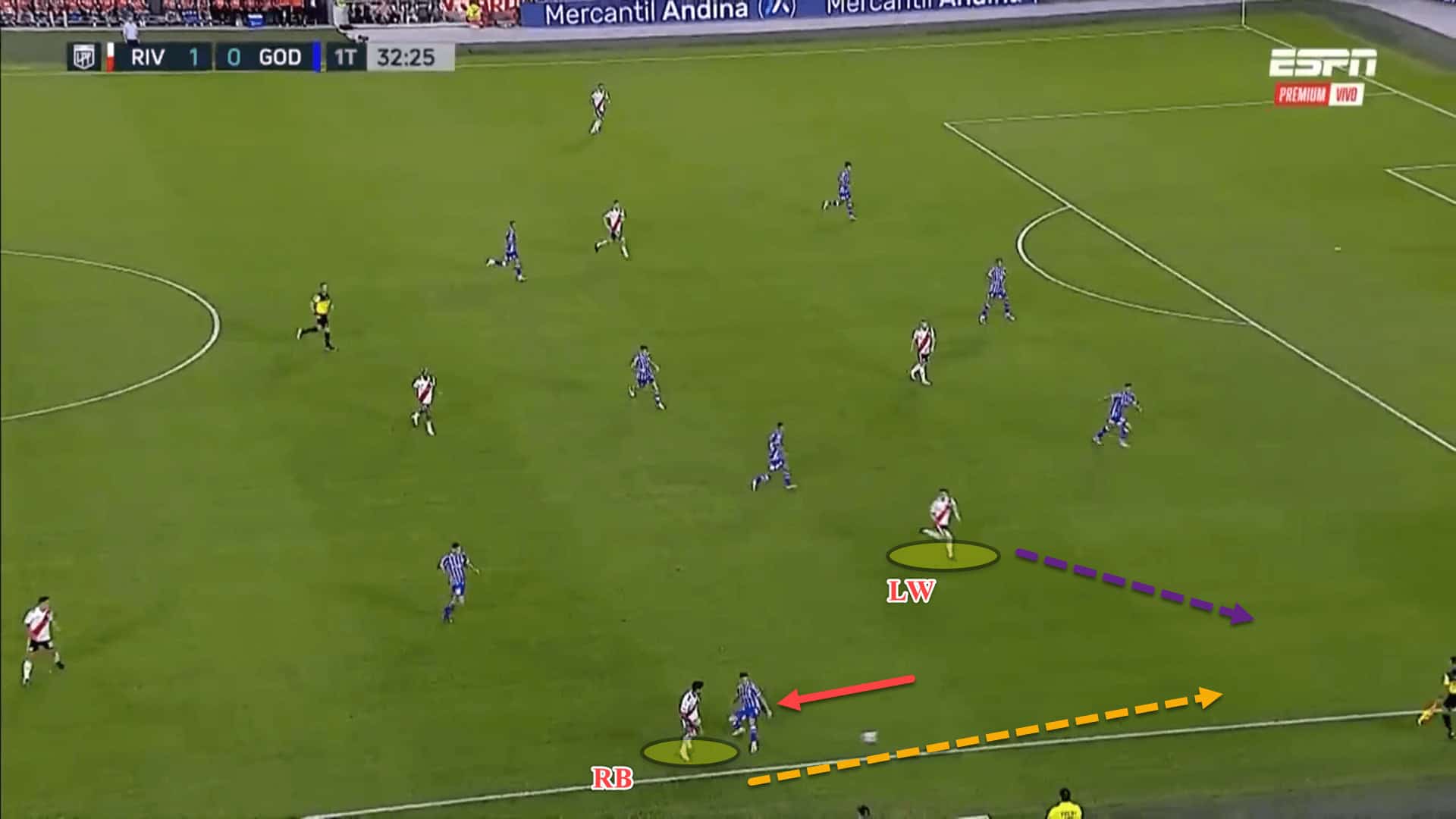
Casco attracts pressure from Godoy Cruz’s left-back, creating a gap between the opposition’s fullback and nearest central defender.
Noticing the space open up, the left-winger José Paladela comes all the way across the pitch to run into the channel to receive from the right-back.
Having picked up possession in the channel, right-back Casco makes an underlapping run and is played in by Paladela before driving it low into the box, creating an opportunity for his team which came close to a goal.
This move all stemmed from having free movement across the midfield and forward line, dragging players out of position and attacking vacated space.
In this sense, there are no defined patterns of play as such, just merely principles of play and freedom that the players abide by to play fluid football.
Selflessness is encouraged.
Making unnoticeable runs to create space for teammates to receive is part and parcel of playing under the former Man City defender.
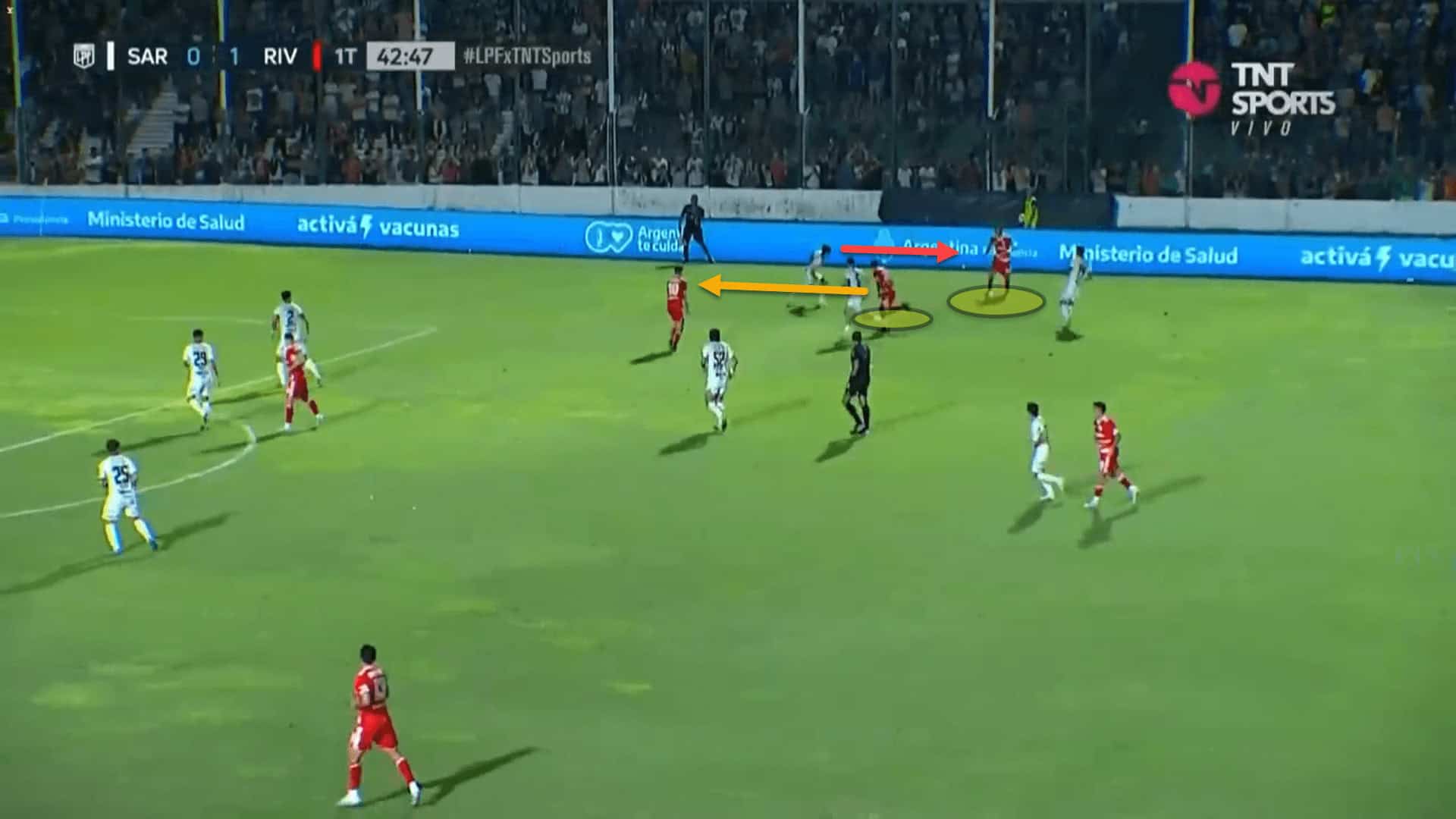
Here, the ball-carrier is under pressure from the Sarmiento fullback while another runs in behind to attack the vacated channel at the back.
Chances are, the player attacking the depth will not receive the ball, given that the opposition’s fullback has closed off the passing lane.
However, this run did drag the nearest opposing players away to track him, causing an obvious passing lane to open up inside.
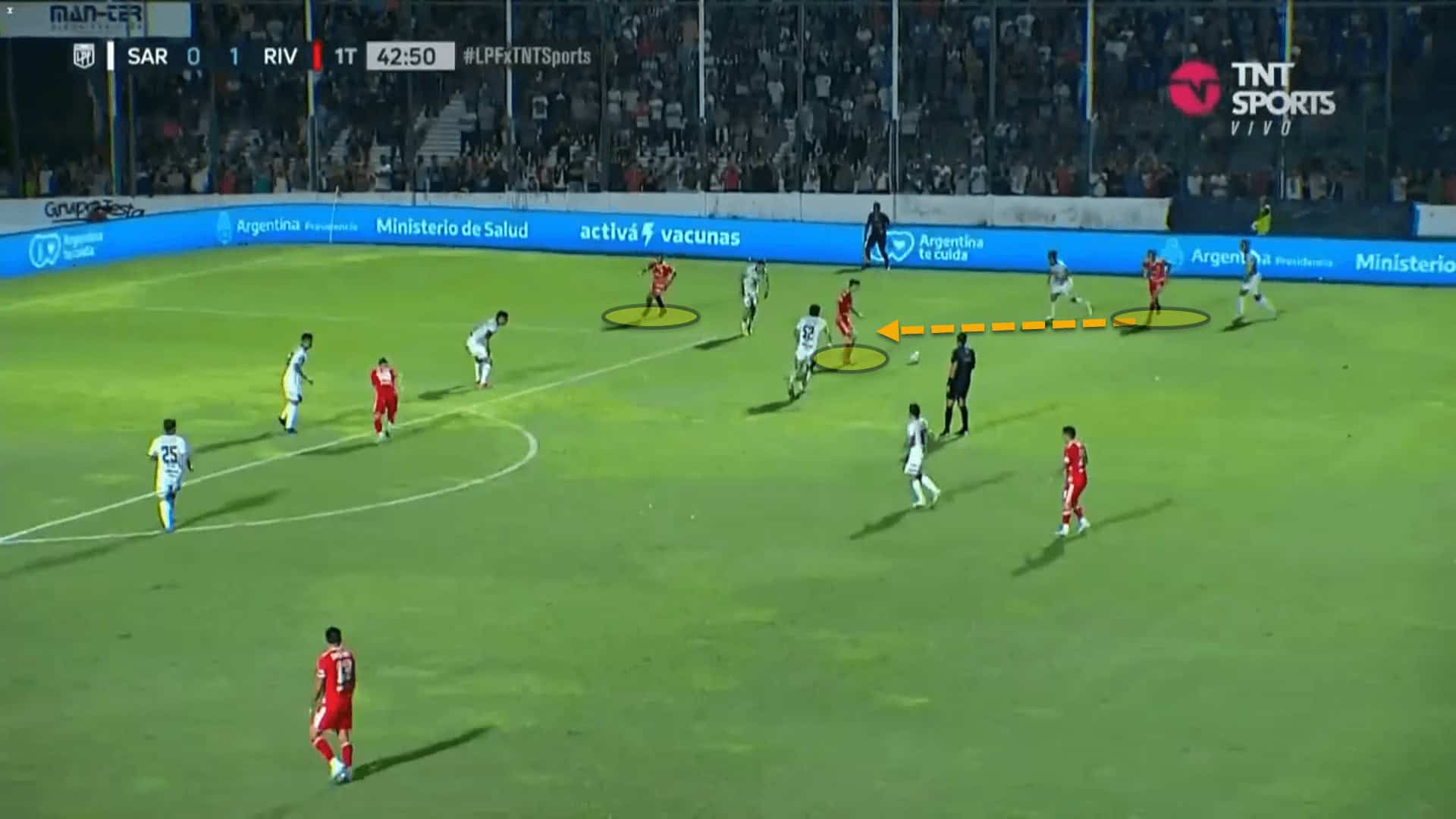
The objective is not just to move the ball quickly to create holes in the opponent’s defensive block, but to make runs and drag players away which causes gaps to open up for someone else to move into to receive.
In this sense, Demichelis’ philosophy seems to have more tinges of a Marcelo Bielsa side than one led by Pep Guardiola.
The off-the-ball movement is a joy to watch at times as well as seeing the understanding from his players about where each other are on the pitch.
Vertical play
The one key principle Demichelis wants to see from his side is vertical play.
This doesn’t mean hitting long balls in behind, but simply that, if a forward pass is on to a player between the lines, play it.
Demichelis is clearly not a fan of having possession without a purpose.
Having the ball is merely a tool to attack and play scintillating stuff.
As aforementioned, the intense off-the-ball movement from his players is a manner in which to pull the opposition’s block apart and to create gaps between the lines.
When the opponent’s block is stretched and a player between the lines has positional superiority, the pass must be made.
For those who are unclear on what ‘positional superiority’ is, it is when a player has time and space between the lines to receive and drive forward.
River Plate don’t force these passes, but the lanes generally open up as a result of their off-the-ball movement.
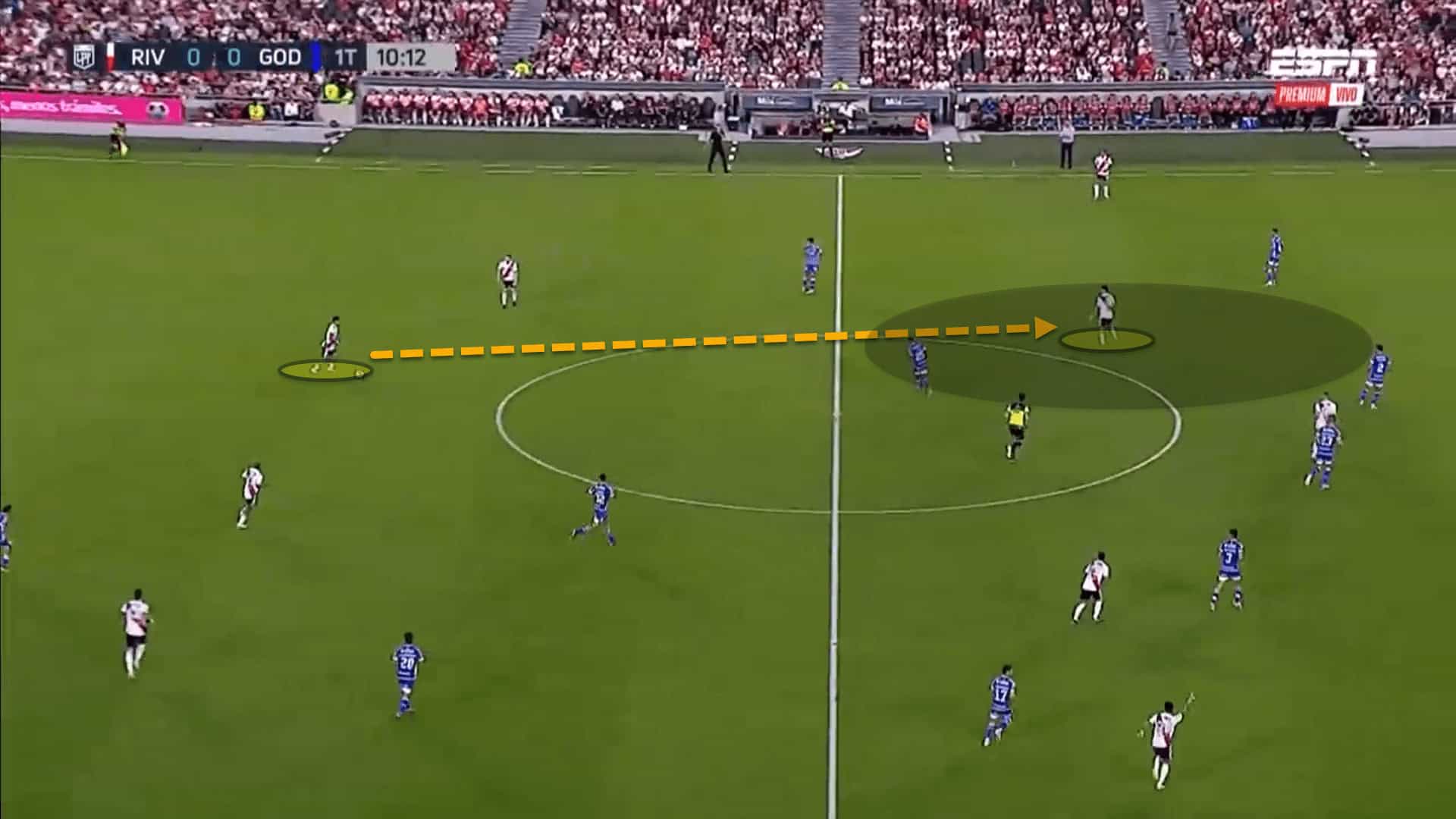
For instance, here, the passing lane has opened up to one of River Plate’s playmaking double ‘10s’ Ignacio Fernández.
Centre-back Paulo Díaz wastes no time getting the ball out of his feet and sliding it through to Fernández who has a perfect body position to receive on his back foot after gaining positional superiority between the lines.
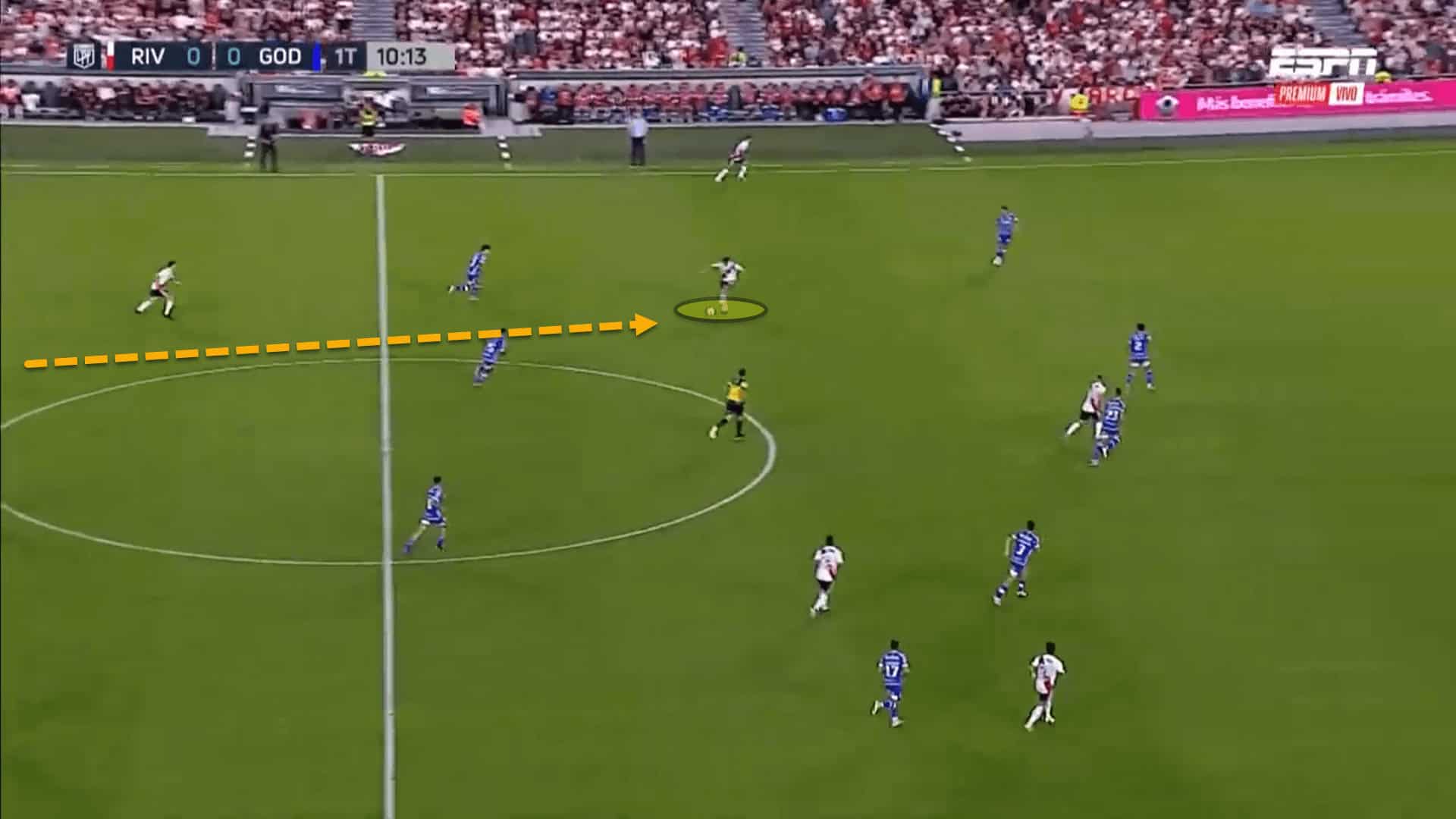
The halfspaces in particular are the main areas of the pitch where Demichelis is keen for his players to play the ball.
The reason being that it is believed the halfspaces give the receiver the best view of the pitch when facing the opponent’s goal as they can see what’s in front of them all across the field.
When observing River Plate’s heat map this season under their new head coach, it is clear that the halfspaces are really important areas to play the ball in order to break through the opposition’s midfield line due to the density of action in these spaces.
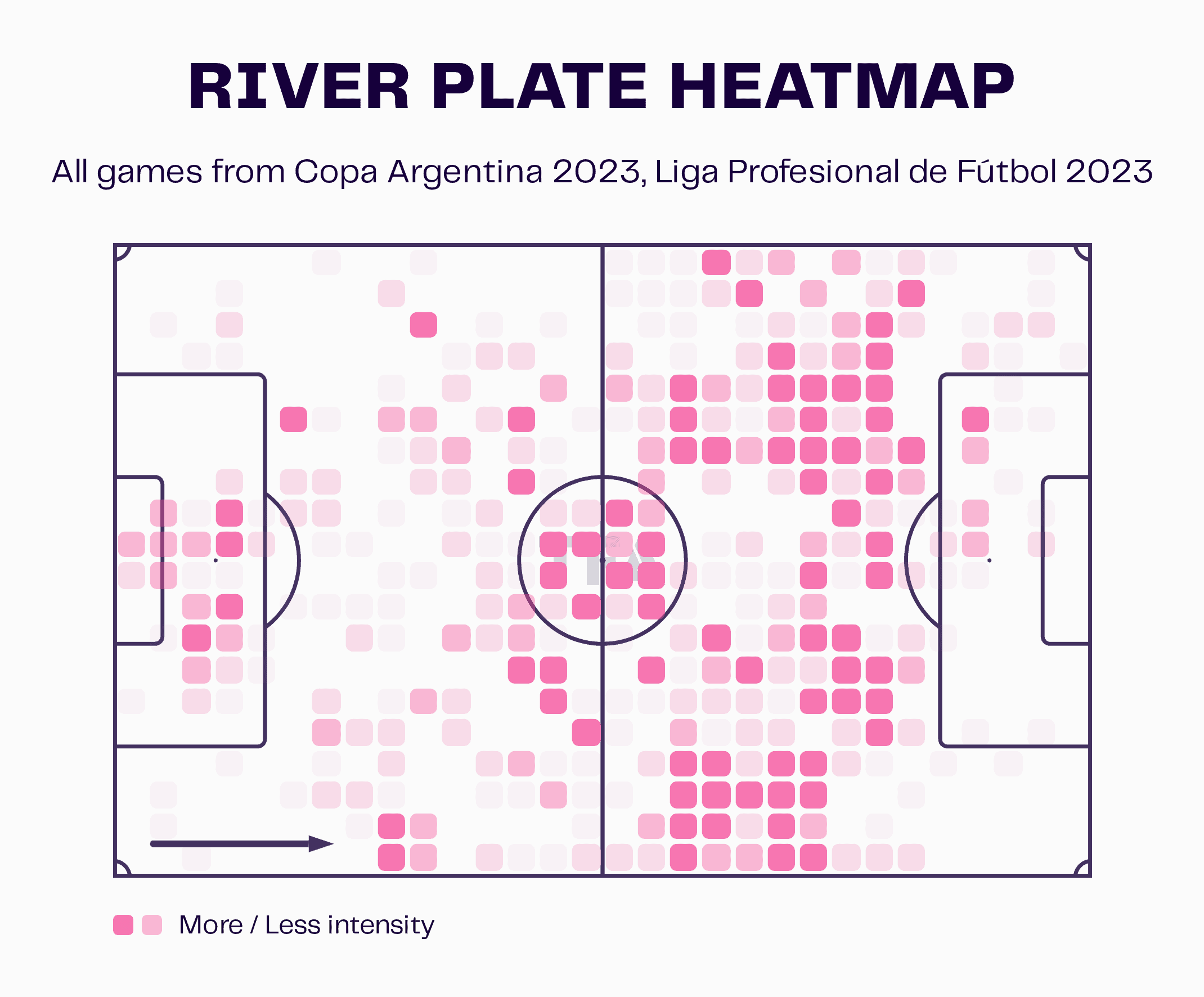
But the centre-forward plays an important role too in helping the team progress and create positional superiority between the lines for his teammates.
Whether it be a one-man or double strike force, the frontmen constantly make runs in behind.
This stretches the space between the opposition’s midfield and backline because the defenders will drop a few yards to track their run.
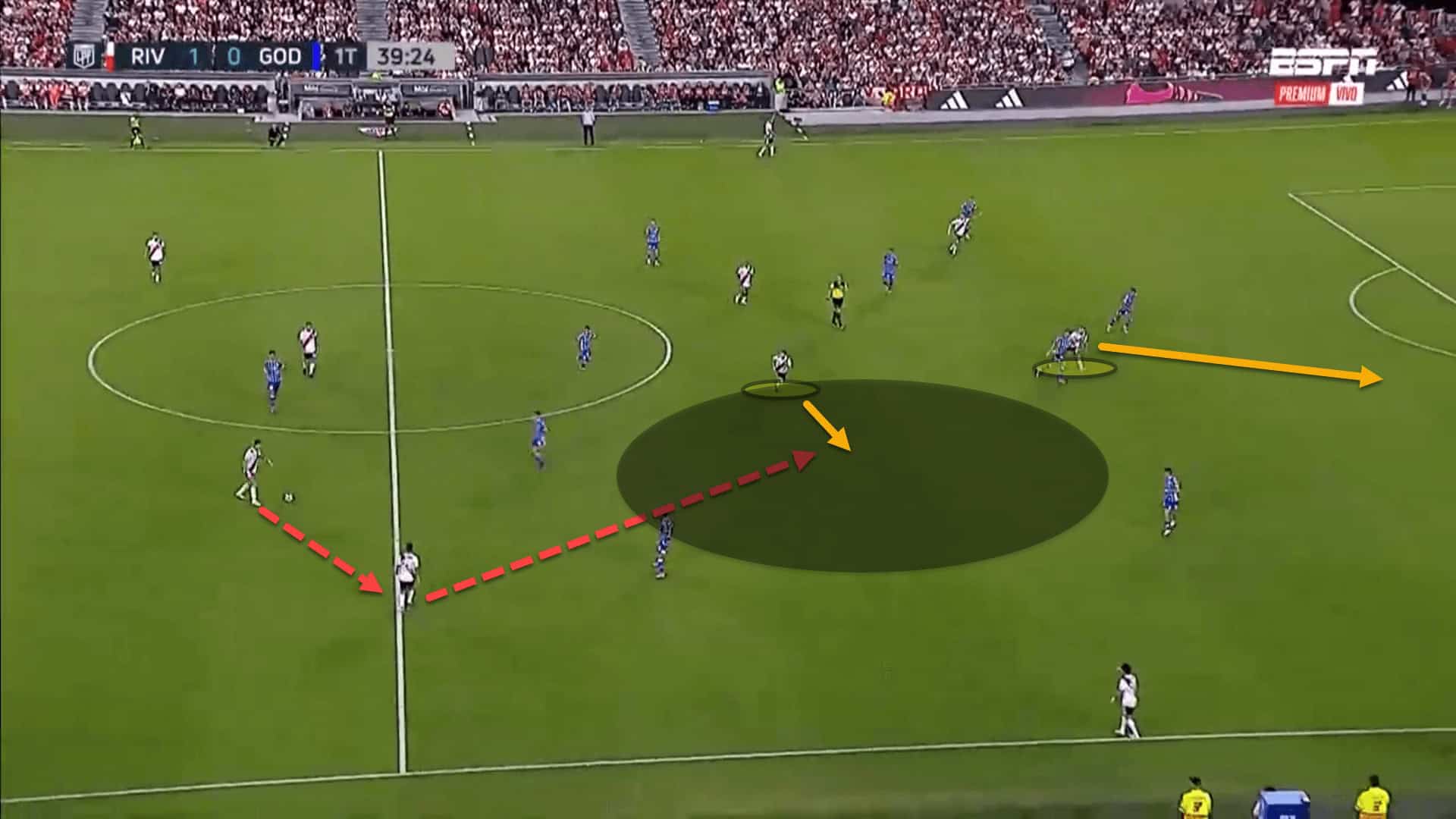
Here, the centre-forward Lucas Beltrán has run in behind.
Of course, there is the possibility that the striker can receive the ball behind the backline with his run, but this is quite unlikely given that Demichelis wants the ball played on the deck as much as possible.
In fact, just 8.74 percent of River Plate’s passes this season have been long balls.
Nevertheless, the run from Beltrán has caused the Godoy Cruz backline to drop a few yards, creating space for his teammate to receive between the lines.
Without the frontman stretching the backline throughout the match, it would be extremely difficult to progress the ball through the lines as there would be less space.
Finishing the attack
River Plate create a lot of opportunities by combining all of these principles.
Linking back to the aforementioned role of the striker, their runs in behind are not just a method of stretching the space between the backline and the midfield.
After a teammate has received the ball between the lines, they can then turn forward and use the run of the number ‘9’ to play into space and create an attack.
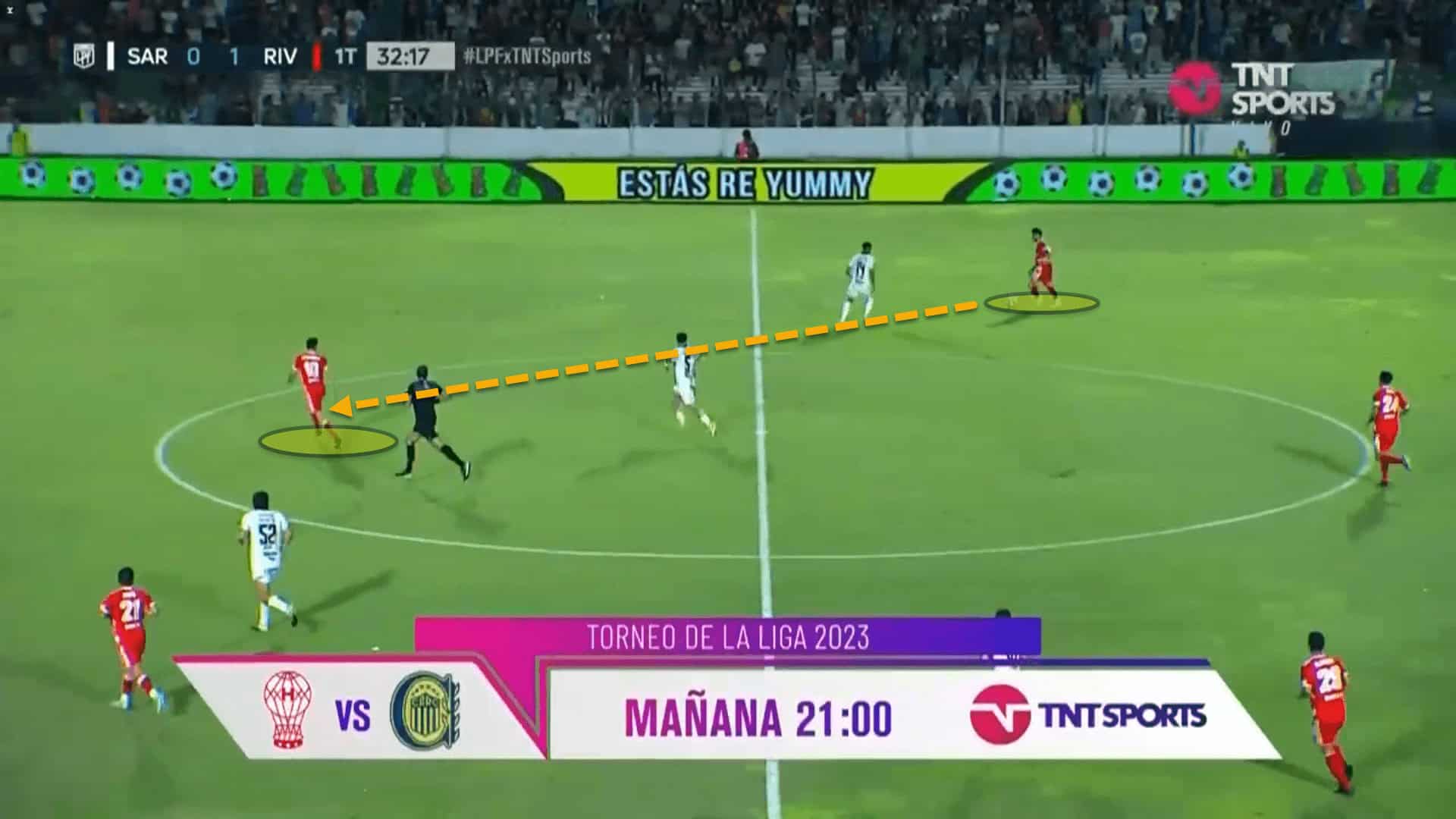
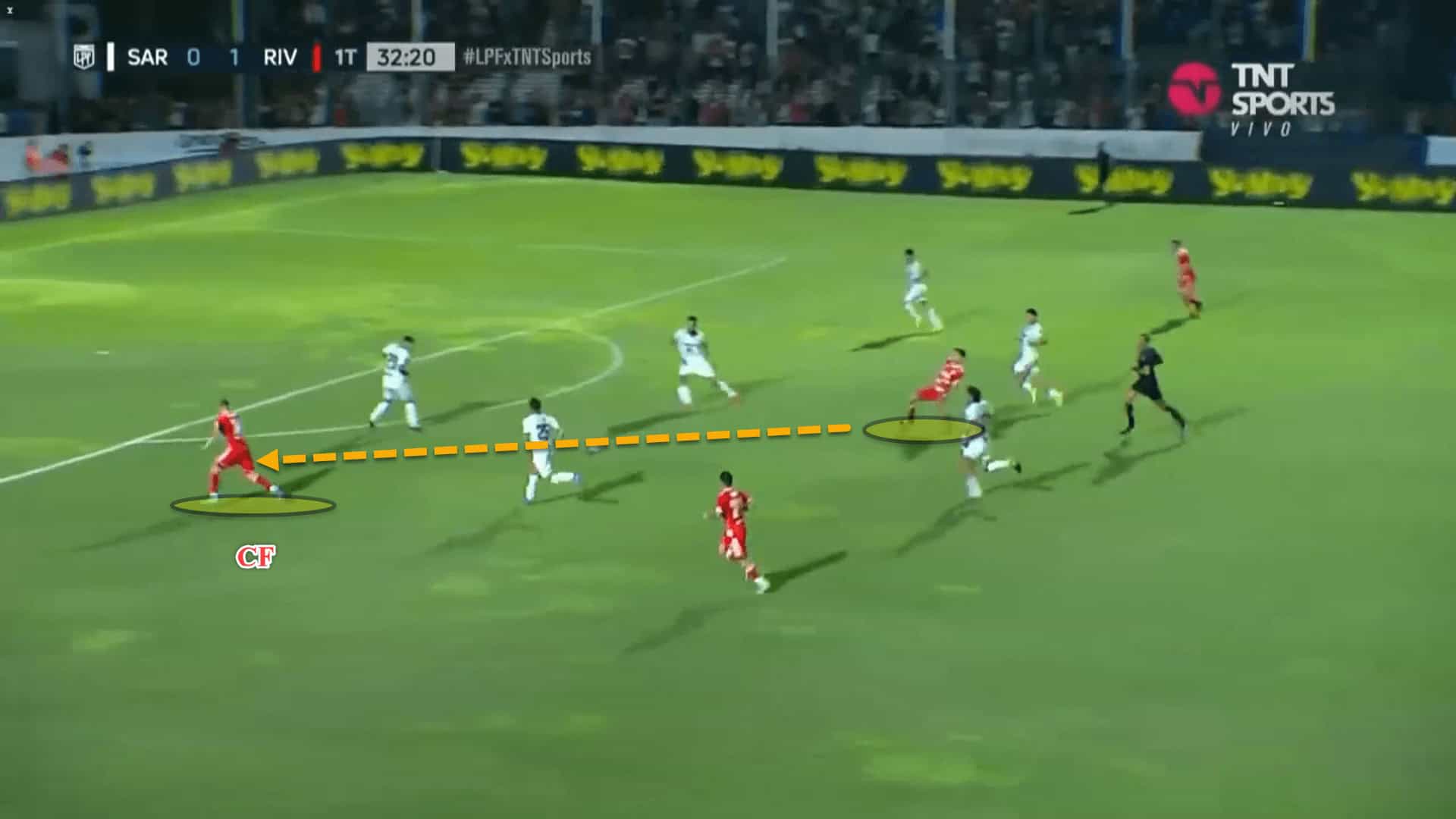
In this example, the striker has made a run beyond the defensive line, creating space for the midfielder to receive from the backline.
Once the midfielder gets the ball between the lines, he turns and slips in the centre-forward who can get a shot away at goal.
Having players between the lines who are excellent at receiving quickly and turning to face forward has been extremely valuable to the head coach, which is why talents such as Ezequiel Barco, Fernández and Paladela have been incredibly useful.
This style of play would be much tougher in a team that doesn’t possess such technically-gifted players.
The central areas of the pitch are where the best opportunities come from, particularly the space directly outside the box which is commonly known as ‘Zone 14’ by coaches.
Demichelis wants his players to create as many chances from this area of the pitch as possible.
Going wide to cross into the box is secondary, hence why River Plate ranked really low for crosses per 90 in the pizza chart in a previous section of this analysis piece.
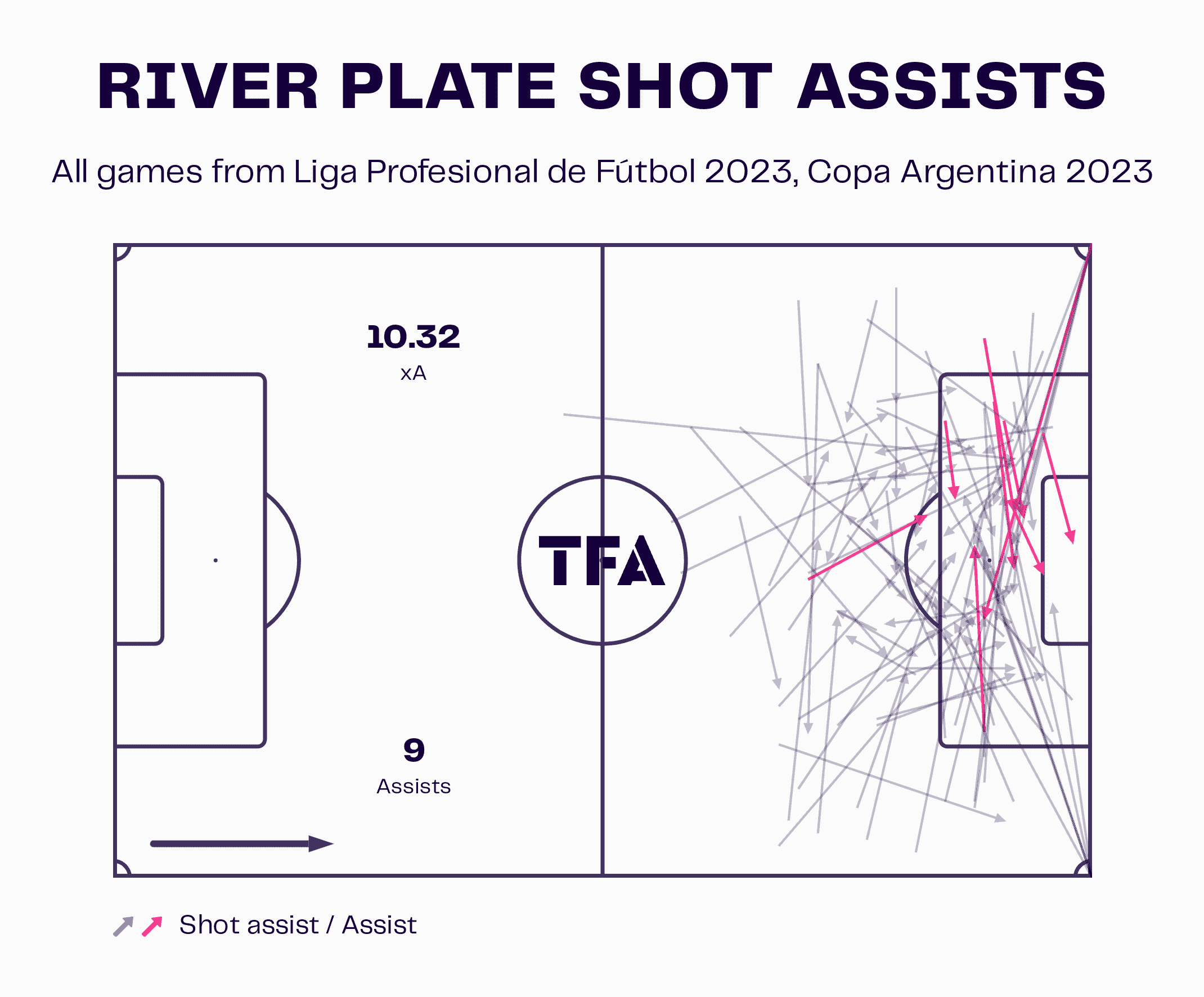
Shot assists are basically passes that lead to a shot on goal.
While there have still been some shot assists from the flanks – particularly from crosses which are to be expected – there are quite a lot which are directly outside the penalty area.
Taking this even further, we can see how many progressive passes Los Millonarios make into the penalty area below, as highlighted in pink.
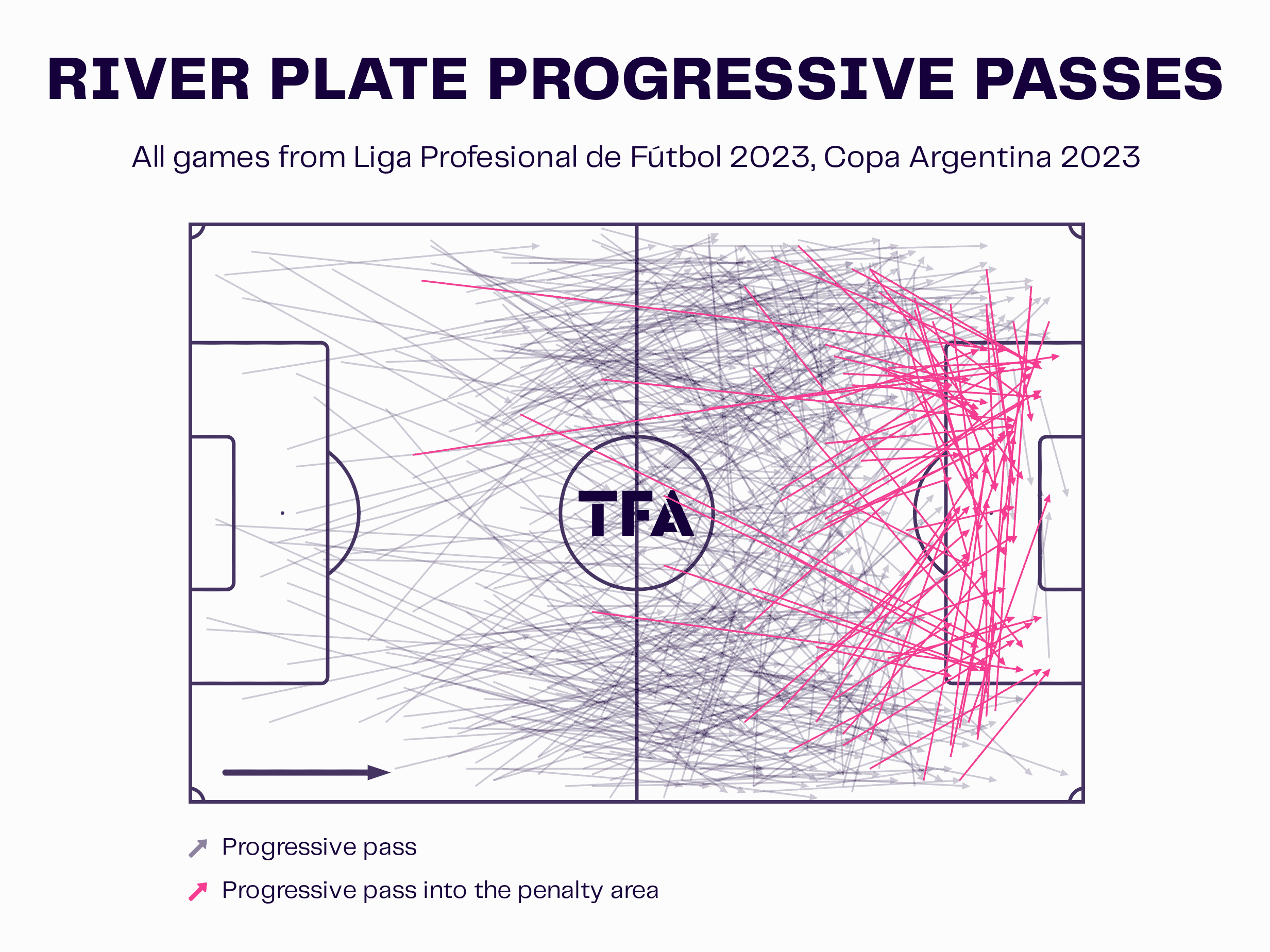
This is the best way to find out the areas where River Plate create chances as line-breaking passes from outside the penalty area won’t always lead to a shot on goal.
Unfortunately, it is inside the penalty area that River Plate are still lacking a little under Demichelis.
The side are topping the table as things stand and have scored more goals than any other team and have even bagged 17 times in all competitions so far.
However, five were penalties.
Overall, River Plate are actually underperforming their expected goals by almost 2.
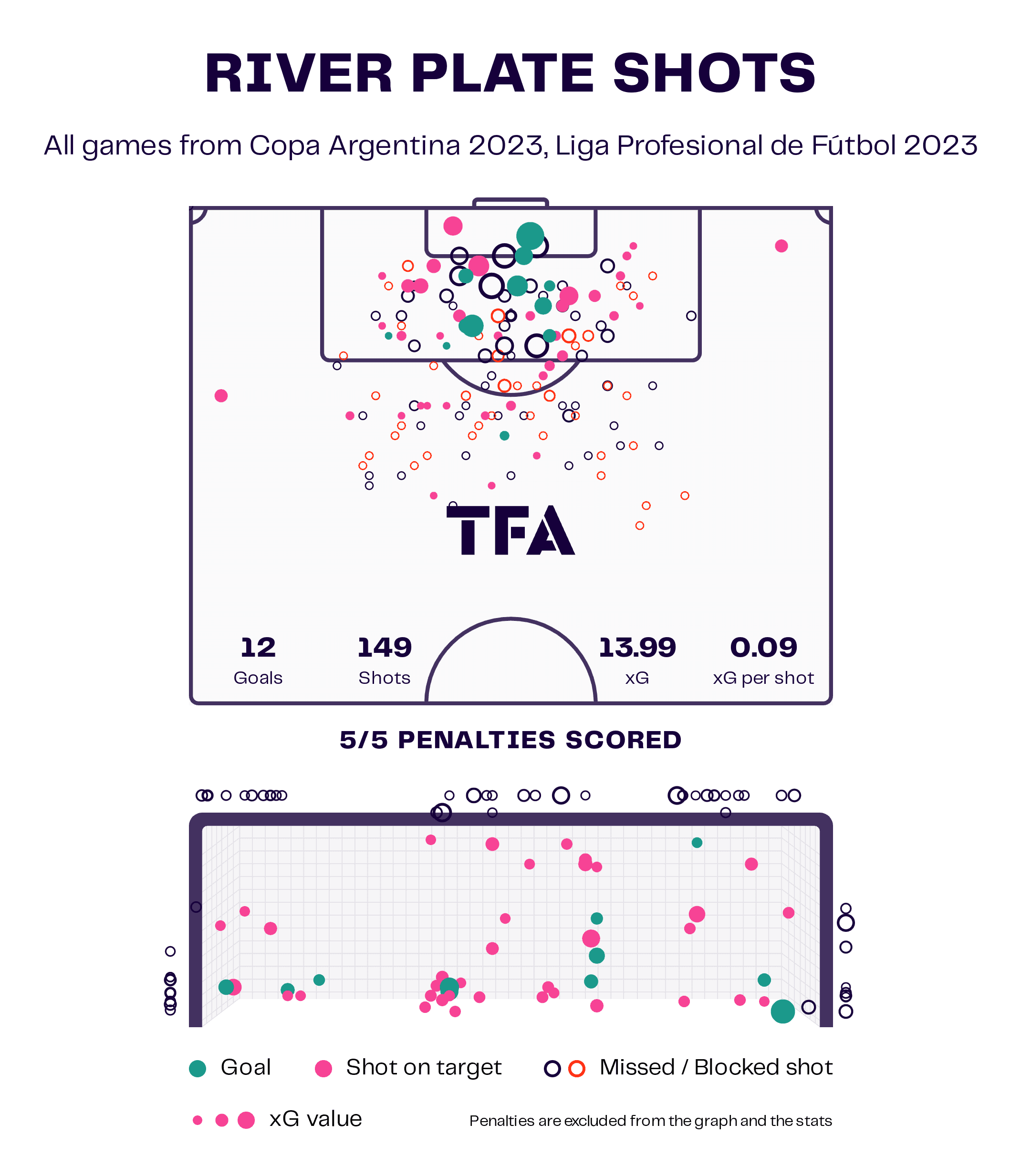
This is not an immediate concern as the season is only a few matches in but it may come back to bite them on the backside should the players not start finishing their chances more as the campaign progresses.
Conclusion
When analysing River Plate style of play under Demichelis, the influence of legendary coaches such as Pellegrini, van Gaal, Guardiola and even his compatriot Bielsa are clear to see.
Los Millonarios are a joy to watch at times, combining tactical and positional intelligence with freedom from the sidelines that not many teams are offered nowadays, while the head coach has proven that formations in possession have become largely irrelevant.
Attempting to analyse River Plate under the scope of positional play and formations is far from optimal.
Principles are what matter to Demichelis philosophy.
His side are much more fluid than his predecessor which is a massive change from previous seasons under Gallardo, but the avid supporters will be hoping that their excellent style translates to trophies which is a requirement at the Estadio Mâs Monumental.






Comments